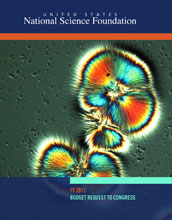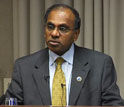News Release 11-029
NSF Presents President's Fiscal Year 2012 Budget Request of $ 7.76 Billion
Request represents 13 percent increase for NSF over current operating level

Budget represents 21 percent of the total federal budget for research at colleges and universities.
February 14, 2011
View of video of NSF Director Dr. Subra Suresh's presentation of NSF's FY 2012 budget request.
This material is available primarily for archival purposes. Telephone numbers or other contact information may be out of date; please see current contact information at media contacts.
The National Science Foundation (NSF) today presented the President's $7.767 billion budget request for NSF for fiscal year 2012. NSF Director Subra Suresh said the request is "designed to maintain the agency's position as the nation's engine of innovation in science, engineering and science education."
The request represents an increase of $894.5 million, or 13 percent, over NSF's current operating level. The President's 2012 budget targets scarce federal resources to the areas critical to winning the future: education, innovation, clean energy and infrastructure.
Suresh said the budget request meets the three major goals of NSF's strategic plan: to transform the frontiers of research and education, to innovate for society by linking fundamental research to national challenges and to perform as a model organization within the increasingly interdisciplinary nature of modern science and engineering.
To meet these goals, specific initiatives and programs in the fiscal 2012 budget request include:
- $60 million for new approaches to science, technology, engineering, and mathematics (STEM) education. These focus on improving teacher training in keeping with the President's goal of preparing 100,000 new STEM teachers, implementing best practices in undergraduate education, and seeking innovative solutions for broadening participation in STEM fields. These forward-looking investments reflect a rigorous prioritization across NSF's STEM education portfolio that included major program terminations.
- $12 million annually for INSPIRE, or Integrated NSF Support Promoting Interdisciplinary Research and Education, a new initiative aimed at changing the way NSF does business by encouraging cross-disciplinary science.
- $577 million for clean energy research and education programs in core disciplinary programs and in interdisciplinary areas such as nanotechnology, information technology and biotechnology.
- $76 million for BioMaPS, or Research at the Interface of the Biological, Mathematical and Physical Sciences, a new program that integrates research from biological sciences, mathematics and physical sciences, and engineering to lead to new theoretical and experimental techniques for clean energy and advanced manufacturing.
- $998 million for Science, Engineering and Education for Sustainability, or SEES, a portfolio of programs launched in fiscal 2011. In fiscal 2012, it will continue to advance climate and energy science, engineering and education to provide a sound scientific basis for shaping policies for environmental and economic sustainability and sustainable human well-being.
- $576 million for investments that will lead to future clean energy and energy efficiency technologies. These are seen throughout the NSF portfolio, in both core research programs and in interdisciplinary, cross-agency activities such as BioMaPS and SEES.
- $117 million for Cyberinfrastructure for 21st Century Science and Engineering, or CIF21, another new, cross-directorate, investment in the FY 2012 budget. CIF21 is designed to develop and deploy a comprehensive, integrated, sustainable and secure cyberinfrastructure framework to accelerate research and new functional capabilities in computational and data-intensive science and engineering.
- $30 million for the National Robotics Initiative, or NRI, a new cross-agency program. NSF will work with NASA, the National Institutes of Health and the U.S. Department of Agriculture to provide U.S. leadership in science and engineering research and education aimed at the development of next-generation robots that that work alongside, or even cooperatively, with people. These robots could participate in manufacturing, space and undersea exploration, healthcare and rehabilitation, military and homeland surveillance and security, education and training, and safe driving.
"This budget request keeps NSF squarely on course with the administration's goal to double the budgets of key basic research agencies," said Suresh.
NSF's annual budget represents 21 percent of the total federal budget for research conducted at U.S. colleges and universities. When medical research supported by the National Institutes of Health is excluded from the total, NSF's share increases to 61 percent.
"Where Discoveries Begin" is not only a concise description of the agency's mission," said Suresh about the agency's motto, "it is a literal summation of NSF's decades of achievement."
NSF supports all fields of fundamental science and engineering, except for medical sciences, by funding the research of scientists, engineers and educators directly through their own home institutions, typically universities and colleges.
-NSF-
-
View Video
NSF Director Dr. Subra Suresh presents NSF's FY 2012 budget request to Congress.
Credit and Larger Version
Media Contacts
Bobbie Mixon, NSF, (703) 292-8485, email: bmixon@nsf.gov
Program Contacts
Michael C. Sieverts, NSF, (703) 292-8260, email: msievert@nsf.gov
Related Websites
NSF FY 2012 Budget Request to Congress: http://www.nsf.gov/about/budget/fy2012/index.jsp
Innovation for a Competitive Advantage: http://www.nsf.gov/news/news_summ.jsp?cntn_id=118678
Next Generation Computing and Communications: http://www.nsf.gov/news/news_summ.jsp?cntn_id=118677
The Foundation for the Next Generation of Innovation: http://www.nsf.gov/news/news_summ.jsp?cntn_id=118674
Science, Engineering, and Education for Sustainability: http://www.nsf.gov/news/news_summ.jsp?cntn_id=118675
Creating a World-Class Science and Engineering Workforce: http://www.nsf.gov/news/news_summ.jsp?cntn_id=118676
The U.S. National Science Foundation propels the nation forward by advancing fundamental research in all fields of science and engineering. NSF supports research and people by providing facilities, instruments and funding to support their ingenuity and sustain the U.S. as a global leader in research and innovation. With a fiscal year 2023 budget of $9.5 billion, NSF funds reach all 50 states through grants to nearly 2,000 colleges, universities and institutions. Each year, NSF receives more than 40,000 competitive proposals and makes about 11,000 new awards. Those awards include support for cooperative research with industry, Arctic and Antarctic research and operations, and U.S. participation in international scientific efforts.
Connect with us online
NSF website: nsf.gov
NSF News: nsf.gov/news
For News Media: nsf.gov/news/newsroom
Statistics: nsf.gov/statistics/
Awards database: nsf.gov/awardsearch/
Follow us on social
Twitter: twitter.com/NSF
Facebook: facebook.com/US.NSF
Instagram: instagram.com/nsfgov

